Welcome to the post- OPENLab panel. OPENLab 2014 took place over the course of 10 days from 18 July – 27 July 2014 in Bloemfontein as part of the Vryfees Festival; and then at Modern Art Projects (MAP) in Richmond where the bulk of the residency took its effect.
OPENLab 2014 was an experimental platform that engaged in critical dialogue about art making in the public realm among creatives in interdisciplinary fields.
In this two-part dialogue, 13 of the 15 artists reflect on their experiences.
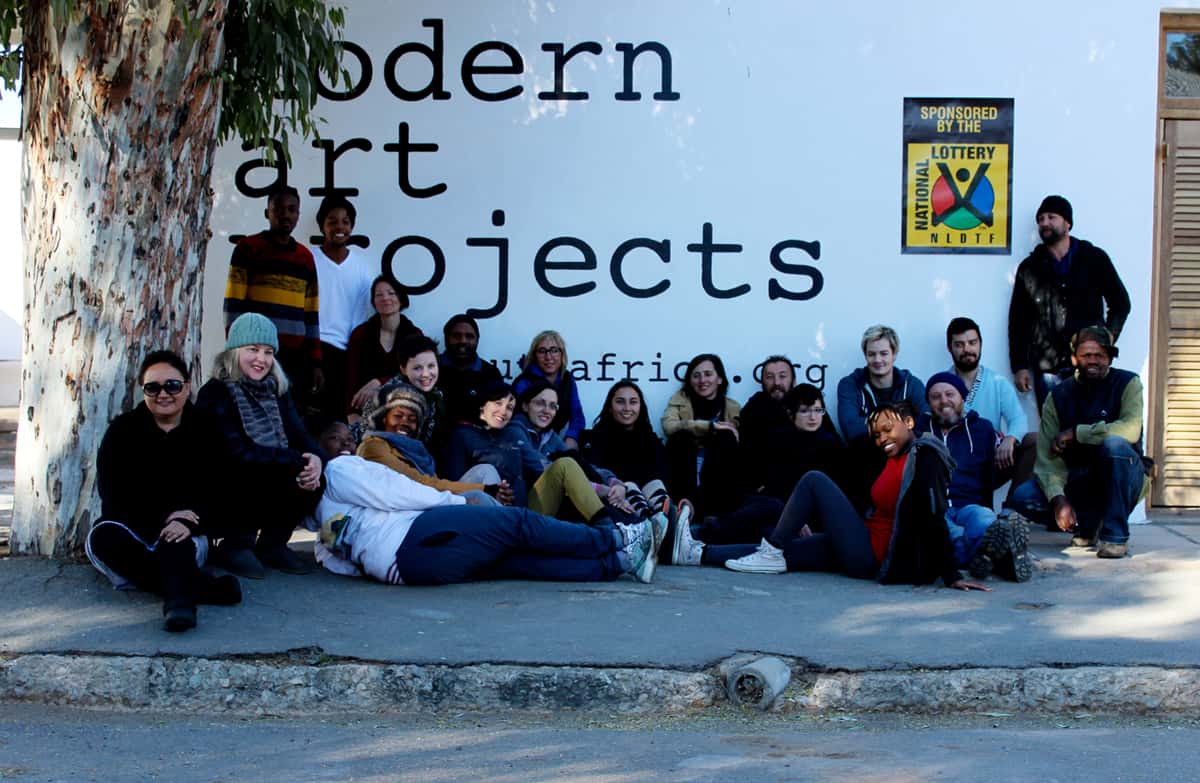
Photograph: Louis Krüger.
OPENLab 2014 was developed by curators, designers and artists Carli Leimbach (AU), Paul Gazzola (AU), Lynda Roberts (AU), Tècha Noble (AU), Bec Dean (AU) and Jay Pather (SA) as part of the Program for Innovation in Artform Development (PIAD) initiated by the Vryfestival and the University of the Free State.
Other facilitators include Phillipa Tumubeinee (SA, Architect & Designer), Nadia Cusimano (AUS, Performer & Dramaturge) and Lee-Ann Tjunypa Buckskin (AUS, Artist & Educator).
It was funded by the Australia Council for the Arts and the National Lottery Distribution Fund (NLDTF) and supported by Map (Modern art projects) – South Africa.’
Selected artists in residency:
Kira Kemper, Sethembile Msezane, Nadja Daehnke, Elgin Rust, Lesiba Mabitsela, Wayne Reddiar, Adelheid Camilla von Maltitz, Nieke Lombard, Sandile Radebe, Roxy Anne Kawitzky, Francois Knoetze, Siphumeze Tafari Khundayi, Sonia Radebe, Gavin Krastin and Phumlani Ntuni.
Unfortunately, Gavin Krastin and Phumlani Ntuni were unable to contribute to this conversation.
What did you expect of OPENLab and what was its outcome?
Sethembile Malozi Msezane: Well, the website said exactly what to expect of the lab, “Up to 15 Artists from across South Africa will participate in the Lab, led by national and international facilitators. The opportunity is open to creative practitioners working in the visual arts, performance, architecture, fashion, dance, new media, sound art, design, community arts and other creative pursuits.
Participating artists will explore new approaches to site based practices working across different communities, disciplines and geographical contexts. The emphasis is on participation, critical thinking, discussion and the creation of new ideas.
OpenLab is a place for free experimentation and open dialogue. It is a nurturing, supportive and responsive space for artists and facilitators to share, exchange and challenge each other.”
I usually go into new experiences with an open mind; I try not to expect anything so that I can fully immerse myself in the experience. What I got out of OPENLab 2014 were new methods of performing that I might have shied away from initially, as performance is a new medium that I am working with.
Nadja Daehnke: Like Sthe, I approached the lab with an open mind, but loved the combination of the conceptual, the visual and the performative. As primarily a visual artist (with some experience in organising and conceptualising performance work), it was wonderful to be involved in exploring my own body as art material. I realised how rare and special it is to be able to do so with other people that one completely trusts at that moment, and in an environment which is non-judgmental and non-hierarchical.
Kira Kemper: I did not expect the lab to be as performance and movement oriented as it was. However, I was pleasantly surprised at my willingness to experiment and push myself out of my comfort zones. I think the environment was quite nurturing and supportive which left me with the confidence to explore things that I would not ordinarily engage with.
Elgin Rust: It is one thing to read about what is planned… quite another to be fully immersed in the process. I was challenged everyday in some manner. It was tough at times but always rewarding!
Sethembile: I agree with Kira; our comfort zones were stretched. However, each person chose how far he or she was willing to push themselves. Also, as the lab was interactive, we often brought up highlights in each other’s works that an individual could have overlooked.
Lesiba Mabitsela: At the lab I expected to develop the ideas that at times paralysed my thinking and creative making process. The openness of the facilitators and fellow artist allowed me to express my ideas without judgement. I would say it was a good first residency and through the residency I’ve been able to identify the key to my works.
Kira: I like what Lesiba says here about developing ideas that paralyzed his thinking. I felt this way during the ‘ideas generating project’, where we had to develop other people’s proposals and then make a performance based on these further developed proposals. I would ordinarily run and hide from this structured situation, however I was truly surprised at the outcome and even inspired.
Wayne Reddiar: OPENLab 2014 has been an incredible experience where I have learnt new processes in creative departure, expanded my practice range, made incredible friends, found new potential collaborators, and developed a relationship with the intriguing town of Richmond. This feels like the beginning of a new chapter for my practice.
Adelheid Camilla von Maltitz: I expected to be challenged and I hoped that I would learn and grow from the experience. I thought that I might not manage to grow. I think the residency was structured very well. It was challenging but it was not a painful experience for me, I felt surprised and happy at my own personal growth.
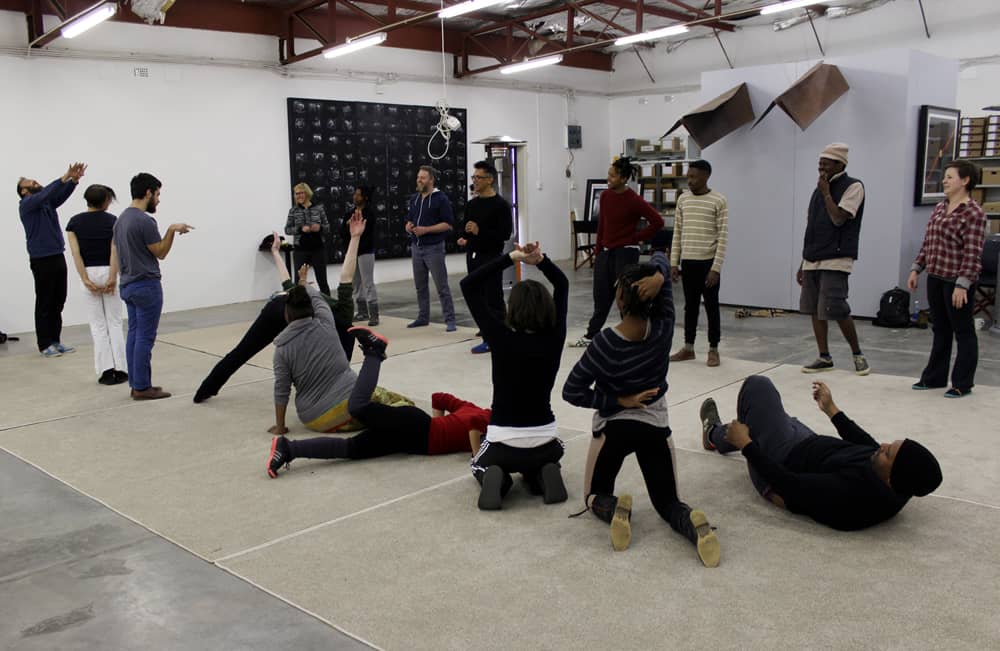
Group games. Photograph: Louis Krüger.
Please discuss the transition from Bloemfontein to Richmond.
Sethembile: Looking back, Bloemfontein felt like a non-space for me- or maybe a space I could not identify with. I did not feel the joyous festivities of the Vryfees Festival. I either felt ignored or stared at during the festival as a black woman, especially in the beer tent. Meeting so many new people at the same time also took a bit of getting used to.
Surprisingly I felt more at home in a ghost-town like Richmond. I suppose it’s because I’m accustomed to small towns- part of my upbringing was in a homestead in KZN. The real work began in Richmond, and I found that it was easier to adapt there. The activities were engaging and this is where I got to know my fellow participants even better.
Kira: Both Bloem and Richmond were relatively unknown to me. I have only ever driven past both of these places. I found the Vryfees Festival in Bloemfontein quite odd. It seemed to be a kind of excuse for binge drinking at night and a very busy market in the day. However here we managed to have very important discussions and conferences around issues of culture that for me framed much of our discussions that then happened in Richmond.
Wayne: The events lined up for us in Bloem, especially the brick-making session and Pecha Kucha, were really great in that they allowed us to get to know each other. I felt really privileged to be part of such a great group of artists and to be led by the amazing facilitators. This allowed me to really trust the creative exercises, interactions and collaborations that emerged during the residency in Richmond.
Adelheid: I think the transition from Bloem to Richmond was very important for me. In Bloem, where I currently live and work, I was still feeling stuck. Once we were working in Richmond I felt that my mind opened up. Being away from home was essential to get away from my daily realities and let my mind focus on the residency.
Lesiba: The Bloemfontein experience kind of charged the rest of my subject matter for the whole residency.
Realising that we were staying on the very same university hostel premises where racist scandals are prominent made me feel as if the festival was more of a distraction to the real issues surrounding it.
Realising that we were staying on the very same university hostel premises where racist scandals are prominent made me feel as if the festival was more of a distraction to the real issues surrounding it.
Thereafter I went out searching for the untold truths about the festival and university. I had a rather productive conversation about this with Molefi who had been studying at UFS (University of Free State) for some time. We discussed the idea that perhaps the two independent festivals, Vryfees and Macufe, were an instance where the art at present seems to separates communities.
By contrast, in Richmond our art seemed to unite a community. That being said, further research and more conversations with fellow residency participants got me feeling more sympathetic towards the Afrikaans language and culture. I actively tried to be a little more understanding and less vindictive in a country that has sought to demonise a people.
This understanding, though, still by far doesn’t justify separation. I think a form of national beauty could be born if the two respective festivals were combined.
Nieke Lombard: I grew up in Bloemfontein, have my family there, attended that very University and have seen the Vryfees Festival many a year. To come back to it as ‘outsider’ looking in critically got my emotions rolling up and down– leading to an overriding sense of frustration. I feel that the festival is stagnating and I got the same old feeling I got while nearing the end of my studies, a restricted sense not unlike bumping my head against a ceiling.
Richmond was an alien place that took me away from past contradictions and tinted nostalgia to an uncharted territory. Going from one known ‘uncomfortability’ to an unknown ‘uncomfortability’ which made it the more challenging.
Both Bloemfontein and Richmond took us outside of comfort zones. Reflecting back on it, in its most basic form, the questions I grappled with were: how do you enter a space, how do you choose to engage with it and why do you engage with it in that way?
I got to know my fellow participants better when we were on the same playing field; I was too ‘involved’ in Bloemfontein. Richmond was a clean page and we were all in the same boat and that for me was a great shared experience.
What was your experience of Richmond and what concerns surfaced?
Kira: I found Richmond to be a very sleepy small town. During apartheid, the town was divided into a historical town and the township. Many of us wanted to learn more about the people who lived there and their experiences of everyday life.
I believe that the dire poverty that we found there played a unique role in shaping our discussions around culture, race and society. OPENLab was like a pressure cooker and Richmond was an ideal pot, because the issues were inescapable. We were all aware of the pressure cooker-ness of the lab and so we were delicate in our approach to making public work in this context. That being said we also had this unique opportunity to make mistakes, to experiment.
Nadja: On the one hand, the contained space of Richmond was great in that it felt like one could get an overview more easily there – while also always being aware of the danger of making assumptions. On the other hand, the intimacy of the town stripped away a sense of anonymity, highlighting for me the need to be accountable for my actions. This was relieved by the discussion around community views of previous art projects.
I found Roxy’s active decision not to produce work in the public realm very interesting in this regard. I fully understand her position and I too was hesitant about seeing Richmond as ‘our petri-dish’, our playground to develop ourselves, rather than as a hugely complex space in which all our actions have potential ramifications.
Lesiba: As you know Wayne Reddiar, I found the relationship between poverty and self-esteem interesting. I tried to convey this in my final presentation to uplift a community who felt that they were not masters of their own destiny. Art seems to be a link which can heal any links broken by history. The kids and their involvement on our presentation day was evidence of this.
Wayne: Lesiba, I agree. One of the most moving moments for me was finding a chair in a school, with the following words written in Tipex: “I am not human being.”
Sethembile: I loved being in Richmond. Perhaps it was the combination of the talented, good people, exciting, engaging happenings, good food (bless Modern Art Project’s Harrie, Morne and the cooking staff’s cooking) as well as good wine. I found that my energies were really focused into embodying the experience of being an experimental artist in a residency that allowed for such freedom.
The issues that surfaced for me were the disparities of the town and township: the empty houses and unused facilities in the town and over-crowdedness, lack of jobs, no paving and limited facilities in the township.
Adelheid: I had a good experience of Richmond overall. The poverty and hunger in the town is a real concern to me. However, as a space it had a positive vibe and gave me a sense that things were slowly changing in a good way for the people living there. Modern Art Projects (MAP) and the staff running it are wonderful. I think it was a good location for OPENLab to take place
Nadja: Yes, hooray for MAP!
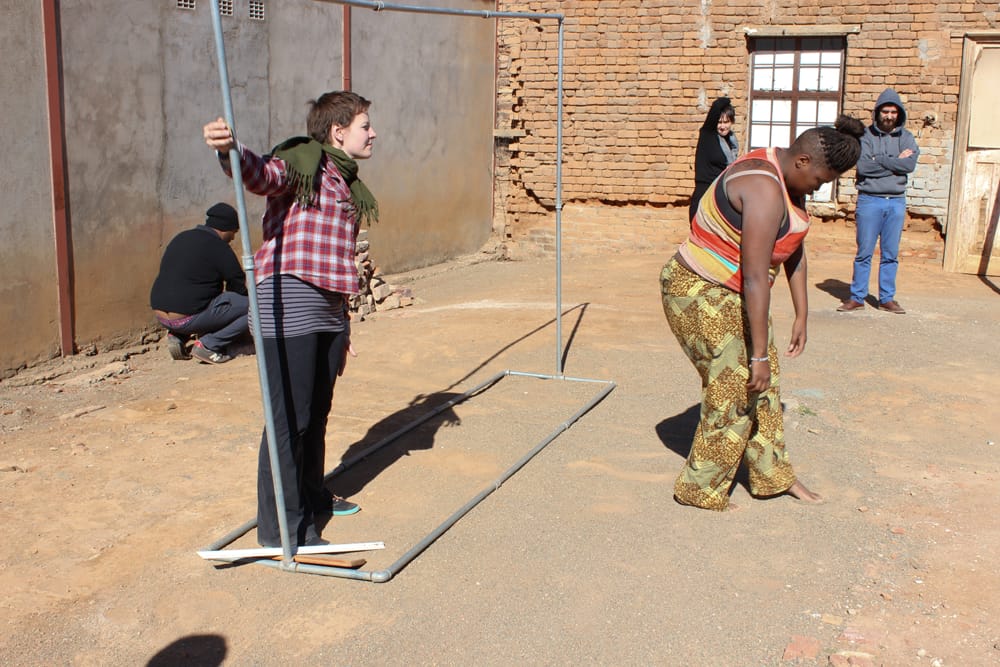
Site performance. Photograph: Louis Krüger.
What were the most challenging moments during the residency?
Nadja: Richmond confirmed the complexity of creating art in and for the public realm- at times it felt like going where angels fear to tread. The programme was structured in such a way that it invigorated instead of paralyzed, yet the challenge came on the last ‘performance and projects’ day. Then, it felt like reality had caught up with experimentation and I was faced with an audience so different to what I had imagined or planned for– a group of approximately 60 small children.
I felt the need to change my planned intervention quite drastically. This need to adapt and adjust rather than stick to a supposed artistic standard, and the question of where a public artist’s primary responsibility lies, is of great interest to me and I would like to explore and discuss it further.
Kira: I did not feel a pressure such as what Nadja describes above. I felt the framing and context of the lab allowed for us to be fluid in our actions in public space. The public was unexpected but this is the nature of public space and it is the joy of working in this way too. I felt the freedom to play, especially surrounded by kids.
Street Whyz (Sandile Radebe): I was challenged by the weather, Richmond can be very cold in comparison to Jo’burg. The school principal (Mr. Sampies), Elvis and I managed to paint the school’s sign in one day. I got to collaborate with the members of this community in one day against the snowy weather and finished the task on the day. I found myself pushed a lot, and also found myself doing much more than what I expected of myself.
Lesiba: Wayne Reddiar helped me on the first project. I found it difficult to trust my own ideas and to navigate unfamiliar spaces alone. I guess his lecturing background helped in that sense.
Elgin: Yup, learning to trust was key. Trusting in one’s own ideas/perceptions as well as trusting the group allowed us to share, care and grow.
Sethembile: I agree with Sandile. Richmond was cold, arid and dusty. My skin got really dry and developed an allergic reaction. My hands swelled up slightly (apparently that had something to do with the sea level). In one of the exercises where we had to try and perceive a minute without using any device to measure time, Sandile made me realise that I blinked quite often and that’s how he counted his minute. My eyes were dry from all the dust in the air, especially in the township.
Adelheid: For me, it was very challenging that the first few days of the residency were so physical. I felt like a fish out of water. I think it was wonderful to be pushed out of my comfort zone and it opened my brain in a different way. I felt like I could see or sense the world around me much more clearly. Another big challenge was taking my daughter with me on the residency. The facilitators and all the residency members were incredibly supportive. I had the attitude that I had to make the best of it even though I missed a few events during the evening because I had to go breastfeed and put my daughter to bed. Even though it is difficult taking a child with to a residency I would encourage other moms who are still breastfeeding to go for it.
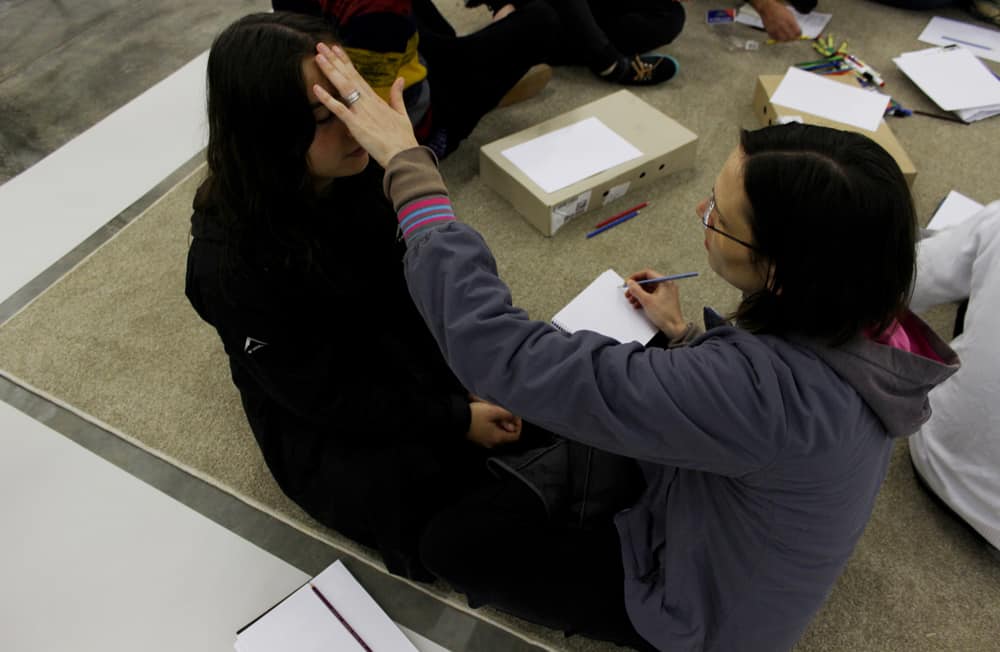
Blind face drawing. Photograph: Louis Krüger.
Please comment on the structure (or non-structure) of the lab.
Roxy Anne Kawitzky: Firstly, the lab provided a way for participants to strip their work of its regular subject matter, themes and modalities and reduce creative thinking almost to its purely abstract elements. After removing all my practice-related trappings/aesthetics/pet theories, the simple processes that make my work run seemed clearer and easier to track and develop. I think this began in earnest during the movement workshops, which (at least for me), facilitated unplanned thinking, actions and choices, and had almost nothing to do with the way I think or what I might make work about. This established a fluidity, which ran parallel to subsequent discussions, collaborations, etc.
Kira: Roxy has, as always, framed this very accurately. I loved the way each day started with movement or a ball game, which, to my mind, was a device to encourage a collaborative thinking.
Adelheid: The structure of the lab had a great flow. I think there was enough formal structure as well as enough lack of structure for the group to decide on what it is we would do, especially towards the end of the residency.
Elgin: The movement workshops created a platform where participants got to know one another playfully while considering spatial, linguistic and narrative concepts. This created a bond based on trust, which encouraged sharing and experimentation.
Street Whyz: The movement workshops and games allowed for one to let go of any control of one’s own working process. I became more and more reliant on my instinct to create and act.
This also filtered into how I engaged other participants and the Richmond community as well. I learnt to trust what came naturally instead of doing something considered. This basis allowed me to enjoy the residency immensely, and took away doubt in my ideas. The unexpected became a guide to what I conceived of and acted on.
When applying to the residency I did not expect a structure that encouraged me to work from my gut feeling over my intellect. Regardless of this fact, the outcomes were very relevant to my stay, interaction with other participants and Richmond, as well as stretching my practice to new and unexplored territories.
Lesiba: Yes, I agree with Sandile. Thanks; I struggled to answer this before your answer. It’s as if we were being stripped of our “powers” – which would be our usual routines to creating work and it humbled us. Throught his process, we were united in our vulnerability.
It stripped us all of egos that may have been prevalent had Sandile and I brought our familiar tools of spray cans and a sewing machine respectively.
Discuss your interactions with participants that you may have known before as well as those you didn’t. After the residency is there room to collaborate?
Francois Knoetze: OPENLab 2014 was an opportunity to freely collaborate with artists and performers from around South Africa. I liked how the lab allowed for a process based (as opposed to an outcome based) approach to art making. We played a game called ‘Design Charrette’ in which each artist was asked to write down three proposals for public artworks. We were then asked to move one seat to the left, and had five minutes in which to expand on one of the three ideas in front of us. This happened a few times. Finally several artists with vastly different artistic backgrounds, tastes and approaches, had expanded on each idea. The original idea had become fluid and morphed into something completely different from its starting point.
For me, this interaction shifted my ideas around authorship and ownership, creating a kind of freedom that is often stifled when we are too ‘precious’ about our ideas being our own.
My practice is usually centered around performance based work and live, unscripted interactions, so I decided to do something different which would allow me to collaborate with the other artists and to enter into their processes in some way. I set up an ‘art shop’ where the other artists could ‘request’ things that they might need for their own performances/installations/presentations. Roxy requested that I build a miniature set for her Live Action Role Play; Lesiba needed a little model built for his presentation; Elgin requested help with the setup of her installation and other small things of this nature. In this way, I got a glimpse into the way that the other artists work. Often in art practice, we work in isolation and issues around authorship/ownership can hinder interesting encounters between various art forms and styles. This freedom to collaborate allowed for interaction with very few ‘strings attached’ – a free hybridisation of processes, ideas and approaches.
Lesiba: The processes in the lab showed me how narrow-minded an initial idea is.
I feel that, on a subconscious level, my idea development has advanced. I generally felt privileged to interact with talented individuals. Some of the others, such as Francois, were already in the process of doing what I’ve wanted to do when it comes to performance art. It was comforting to know that some of them went through some of the same issues that I regularly have problems with concerning a realisation of an idea.
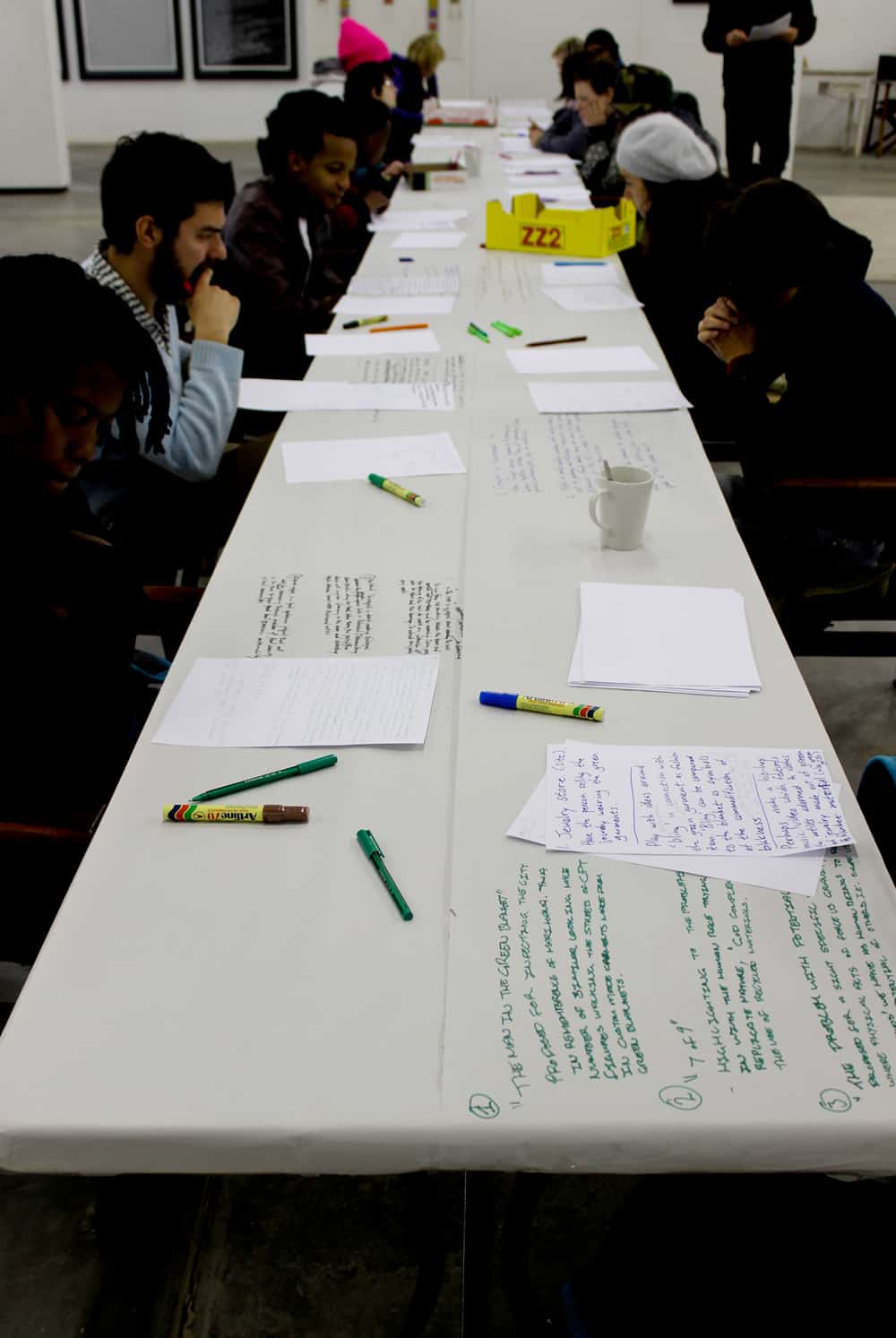
Design Charrette. Photograph: Louis Krüger.
Nadja: Yes, agree with Lesiba. It was awesome to see how each of us had our own talents to share and use. It left me with a great sense of possibility.
Francois: Likewise, I feel like my experience of interacting with other artists provided me with a degree of distance between me and my process of making. Seeing how others approach various aspects of their practice has revealed some things about my own approach that I hadn’t noticed before, and have perhaps been neglecting up until now. I agree with both Lesiba and Nadja, in that OPENLab highlighted, in a very unique way, potentially unexplored terrain in the overlapping of talents and knowledge.
Kira: Agreed. My own practice took a back seat, but I was constantly thinking “what if I applied this to my work”. I found the exercise where we mapped out our processes particularly uniting in that I felt validated in what I previously thought of as creative processes.
Sethembile: Generally, I tend to be an introvert, but if situations call for me to step up I will. I think everyone at the residency will probably say I was one of the most talkative participants. I felt I needed to rise to this occasion as I wanted to learn more and this meant interacting with people I didn’t know, or perhaps knew but was not close to. I hardly collaborate with people and for me this opened up a door to the possibility of shared thoughts and ideas to percolate and create something that could be amazing.
Lesiba: It was rather interesting how leadership in particular was negotiated in our collaborations.
Street Whyz: True, leadership and ownership.
Adelheid: Interacting with the group was easier than I thought it would be. Everyone was really very nice. I did feel a bit more on the outside because I was not living with everyone and I could see that there were very close and strong bonds being made because of being together just about all the time and I was not as much part of that as the rest of the group. But it felt like the group was very understanding of my situation. I was totally amazed at the talent of the group as a whole. They are all are all so, so talented! I think there will be collaboration after the residency, at least at some point for some of the participants.
OPENLab is part of the overall Program for Innovation in Art from Development (PIAD) which is part of the transformation strategy of the Vryfees, and the University of the Free State.
The second part of this dialogue will be available next week (29th August 2014) and will be shared via Art South Africa’s weekly newsletter.



